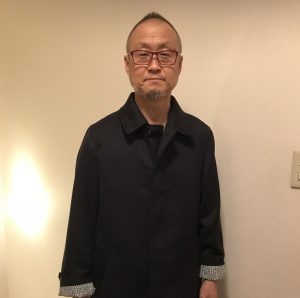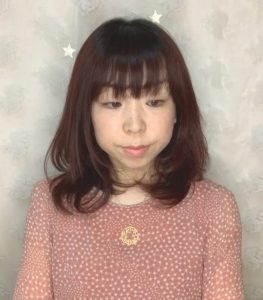#22ゲスト:Ms. Yangsook Choi
The Guest of March :Ms. Yangsook Choi
今月のゲスト:崔 良淑
ジャンル:ポジャギ(韓国のパッチワークキルト)
(POJAGI / BOJAGI –同じ意味で使用)
プロフィール:
韓国の針仕事である“ポジャギ”作家
からむし工房主宰-Karamushi.com
This month’s guest: Ms. Yangsook Choi
Genre: Pojagi (Needle work – Patchwork & Quilts from Korea) (POJAGI/BOJAGI – used interchangeably)
Profile:Pojagi Artist
Korean Needle Work Pojagi Artist
CEO of Atelier “Karamushi”- Karamushi.com
作品
インタビュー音声
Q.韓国のPOJAGI(ポジャギ)の歴史についてまずお話していただけますか?
はい。ポジャギは18世紀後半から19世紀に栄えた韓国の生活用具です。日本でいう風呂敷や、袱紗(ふくさ)のようなものです。ただ、この18世紀後半から19世紀というのはあくまで文献の記録で、現在博物館に展示されているものは朝鮮半島で布が織られていたその昔からではないかと私は思っています。
生活用具としてのポジャギの話ですが、風呂敷や袱紗のような2つだけの機能ではなく、日常生活の中で広く使われていました。パーテーションのように吊るすもの、物の上にかぶせて袱紗のように覆うもの、テーブルセンターやマットのような敷物、風呂敷のように包むもの、他には装飾用のもの、また結婚式のような儀礼に使うもの、最後に信仰的なものがありました。生活用具として普及した背景は朝鮮時代の農業から始まり、織物が自給自足で売られていたことと、住まいが狭いために畳んで小さくできることから空間を利用できたという理由があります。また、小さく使いたい時は小さく、大きく使いたい時は広げることが出来る柔軟性や、物の保管や運搬にとても便利なものだったため広まっていったのだと思います。さらに、その時代の生活哲学が儒教だったのもあり、礼儀を大切にし、ポジャギで物を包み、物と一緒に心を伝えるものとしても考えられていました。
ポジャギは漢字で袱紗の「袱」と書きますが、これは韓国の幸せの「福」と同じ発音をするため、端切れを接ぎ合わせて(ポジャギを)作り、物を包んでおくと福を招くという意味もあります。
―なるほど。ポジャギというとどうしても薄布というイメージがありますが、物を包むのに適した厚地のポジャギなどはあるのでしょうか?
はい、あります。韓国は日本のように四季がある国なので、薄い夏物の布で作られたポジャギは軽い物を包む用途で使われます。時代劇などを見ますと、頭の上に帽子などを被っているかと思いますが、そういった頭に被るようなものをとても大事にしていますので、そういった帽子を包んだりもしています。また、壊れやすいものに対しては綿を入れた厚手のポジャギを使ったり、冬物では宝石などを包んだりもします。
―布は絹ですか?
絹もありますし、夏は麻もあります。特に麻はとても丈夫なので、物を隠す目隠しにしたりとか、もちろん物を包んだりもします。物を運ぶものとしては、よく麻が使われます。
Q.ポジャギの魅力はどのようなところにあると思われますか?
やっぱり布を重ねたときの美しさ、そして継ぎ接ぎの美しさだと思います。
女官服のチマチョゴリってありますよね?それに使われる布は絹と麻が主なんですね。薄い絹を重ねると奥行が出てとても素敵ですし、いろんな表現ができる。麻の場合は縫い代を包んでありますから、そこがシルエットになって重なりの楽しさが感じられます。それと、私は「継ぎ接ぎ」ということは自分の想いとか時間が織物のように交差していく、これがポジャギの魅力で「今を生きる自分の表現」だと思うんです。それが素敵だなと思うところですね。
Q.歴史のあるものですので、現代風にアレンジすることもあると思いますが、どのような作品を作成されていますでしょうか?
やはり古い物を見ると、そこから得るものってたくさんあるんですよね。そこから今よく言われているのが、韓国のポジャギはモンドリアンの絵やパウルクレーといった現代美術のモダンアートと近いものがあります。シルエットとかが抽象的なものなんですね。なので、部屋に取り入れたりしても、例えば額に入れてみたり。日常生活の中ではスカーフにしてみたり。あと暖簾のように飾ってみても素敵ですね。あとは服に取り入れたりもしています。2002年にシャネルがポジャギをデザインした展示会を韓国のソウルでやったんですけれども(https://www.chanel.com/jp/fashion/news/2015/11/pojagi-print.html)(https://fashionpost.jp/news/47822)そこからエルメスに始まり…、エルメスはスカーフにポジャギのデザインを取り入れていたんですよ。そこからフランスやヨーロッパにポジャギが広まっていって、私も本を出したりしたんです。
―なるほど!既に現代のファッションに取り入れられている訳ですね。
そうです!日本でも認められていると思うんですが、ここ数年からはヨーロッパやアメリカでも評価されていますね。
Q.作品の着想はどのようなことから得られていますでしょうか?
デザインでは、自分が感動したものを表現しているんですよ。日常の生活の中で感じているもの。それは空であったり、素敵な音楽であったり、展示会で出会った作品であったり、花の香りであったり、あとは目に見えないものなんですけれど、風の色だったり…。常に自分のときめきそのものが、私のデザインの着想なんです。
―そうなんですか!それだから歳を取りませんよね!(笑)
そんなことないですよ!(笑)
―でもそういったものが無いと、人って老いていってしまいますから、ときめきは必要ですよね。
必要です!本当そういうものって、いつ感じるの?って聞かれるんですけど、やっぱりセンスを磨けば磨くほど感じやすくなると思うんですね。その感性が錆びついたら感じなくなってしまうので、常に研ぎ澄ませておかないと。だから私は常にその部分だけを磨いて、鋭くしているのかもしれません(笑)だから表現したいものがたくさんたくさんあって困っています!だからアンテナっていうのともちょっと違うのかな…。
Q.作品1つ1つに意味が込められているとみていますが、1番特別な作品とそこに込められた意味、メッセージを教えていただけますでしょうか。
沢山あるんですけれども…。藍染をしていた布で服を作って、その布が余っていたんですよ。それで捨てるに捨てられず継ぎ接ぎしていたら、1つの作品になったんです。「Blue World」っていうのを自分のテーマにしているんです。青い世界。その中で順番に作っていっているんですが、3番目にあたるものなんですけれども…。藍染のブルーって空の青でもあって、
海の色でもあって、天地の境もなく…、例えば飛行機に乗ったときに下を見ると、広がっていくばかりで国境がないじゃないですか。海を眺めたりすると、国境がないっていう光景が平和的なものに感じるんです。だからブルーっていうのは、私にとって平和への願いや祈りなんですね。宗教や何かを全部越えたものとして、「Blue World」は自分の平和の表現なんですよ。
この作品が、2016年に韓国で開かれたフェスティバルで、世界アート芸術賞という賞を受賞したものです。これが今は自分の中では思い入れがありますね。まだまだ5番も6番もありますが…(笑)
―素晴らしいテーマですね。
藍=愛(LOVE)とも考えているんですよ。藍染のインディゴブルーとかけて。
Q.作品を作る上で一番苦労したことはどんなことでしょうか?
苦労は…忘れてるんです。作品ができた瞬間に、たぶん布を染めたり色々大変なことはあったと思うんですけど、結局苦労はなくなってしまうんです。全部忘れる!だから次のことを始められると思うんです。
―これは時間かかったなあ、とかはないんですか?
ないない!それが3年かかったものでも、すぐできてしまったものでも、その感覚がなくなってしまうので、答えられないです(笑)そこで考えていたことも全てリセットされるというか。だから死ぬまでやり続けるんでしょうね(笑)
―死ぬまでやるって言いきっちゃった方がいいですね!
そうですね。たくさん作りたいから一生懸命生きないと!
Q.ご自分のワークの中で何か大きな夢や挑戦したいことはありますか?
今後は大きな作品ばかりではなくて、日常生活でも楽しめる小物であったりとか、暮らしを彩るポジャギをテーマにして本を出したいなあと思っていて、今準備をしています。
―いいですね。身近なものですか?
そうですね。身近で感じられるポジャギの魅力とか楽しさを、若い人たちにも良いものだよって伝えたいですね。本当に身近なブックカバーとか、バッグに入れられるようなものだったり。私がポジャギを始めた20年前とかは大きなカーテンとか作る!っていって入っていったんですけど、今の若い人たちはよりもっと色んなことを習いたいんですよね。その中で自分の好きな物を見つけたいんじゃないかなと思うので、そういう面では日常に取り入れる物として小物もやっていきたいなと思っています。
―そういった小物にポジャギを取り入れて、ちょっと他の人とは違ったものを個性を表現して作れたらいいですよね。
そうそう、自分だけの物?たとえ下手であっても、自分の想いを込めて作ることが大切だから…。手仕事や針仕事の楽しさを伝えられるような本を考えたいなあと、2年前くらいから準備しているんですけど(笑)
今になってコロナの影響で皆さん家にいる時間が増えてるし、もうちょっとスパイシーなものが欲しいじゃない?韓国料理スパイシーですけど、色もスパイシーなんですよ!だから今の時期はそういうものも必要なんじゃないかなと思いますので…。
Q.今後の活動で宣伝したいことなどがあればお話しください。
はい。今年の10月18日から24日まで、東京韓国文化院で、ポジャギの展示会を行います。大使館になっているところなんですけれども、そこで日本と韓国で活躍されている作家さんたちの作品を200点くらい展示します。天井も結構高いから吊るしたりもしたいなと。
―フランスで出版されたという本もよければ教えてください。どこで買えるんでしょうか?
これはAmazonなどで購入できます。(https://www.edisaxe.com/le-pojagi)
これで「pojagi」っていう本を出してサイン会に行こうと思ったらコロナ禍になってしまい…、日本ヴォーグ社の方でポジャギの本が出たんですが、それのフランス語版なんですよ。その後英語版が台湾の方で出るはずだったんですが、コロナで延期になり…。トントントンと行く予定だったんですけどね。ただそれだけポジャギの人気があるってことですからね!
―楽しみですね!
Q. Could you tell us about the history of POJAGI in South Korea?
Yes! POJAGI is a Korean household item that flourished in the late 18th and 19th centuries. It is similar to a Furoshiki or Fukusa in Japan.
However, the late 18th to 19th century is only a literary record, and I believe that the items currently on display at the museum date back to the early days of cloth weaving in the Korean Peninsula. (* Furoshiki/Fukusa – a wrapping cloth*)
I’m talking about POJAGI as a tool for daily life, but it was widely used in daily life, not just for two functions like Furoshiki and Fukusa. It was used to hang things like partitions, to cover things like Fukusas, to make table centers or mats, to wrap things like Furoshiki, for decoration, for rituals like weddings, and finally for religious purposes. The background to their widespread use as living tools began with agriculture during the Joseon Dynasty, when textiles were sold for self-sufficiency, and because houses were small, they could be folded and made smaller, thus making use of space. It also spread because it was flexible enough to be used small when you wanted to use it small, and to be expanded when you wanted to use it large…and because it was very convenient for storing and transporting things. In addition, the philosophy of life at that time was Confucianism, which emphasized the importance of politeness, and wrapping things with POJAGI was thought of as a way to convey one’s heart along with the items! POJAGI is written in Chinese characters as “fukus” in Fukusas, which is pronounced the same as the Korean word for happiness, “fuku”.
-I see! When I think of POJAGI, I tend to think of it as a thin cloth, but is there a thicker type of POJAGI that is suitable for wrapping things?
Yes, there are. Since Korea, like Japan, has four seasons, POJAGI made of thin summer cloth is used to wrap light items. In period dramas, people wear hats, and since people view their hats very seriously, they also wrap such hats. For fragile items, we use thick POJAGI filled with cotton, and for winter items we also wrap jewelry.
-Then, is the cloth silk?
Well, yes, we use silk, and in summer we have hemp. Hemp is very durable, so it is used as a cover screen to hide things, and of course to wrap things. Hemp is also used to carry things.
Q. What do you think is the appealing and attractive charm of POJAGI?
I think it is the beauty of the layers of cloth and the beauty of the needlework used with different color fabrics.
You may know “chima jeogori” which is a Korean term for a women’s outfit (costume) consisting of a chima skirt and a jeogori top. The cloths used for this are mainly silk and hemp linen. Layers of thin silk are very beautiful and can be used to create a variety of expressions. In the case of hemp, the seam allowance is wrapped around the fabric, which creates a silhouette and makes the layering more enjoyable. Also, I think that “splicing or putting together” means that your thoughts and time intersect like a textile, and this is the charm of POJAGI, “expressions of yourself living in the present”. I think this is the charm of POJAGI!
Q. Since these objects have a long tradition in history, I’m sure you sometimes arrange them in a modern way. So…Could you tell us what kind of contemporary work you have made or are making?
I think there are many things to be gained from looking at old things. It is often said that Korean POJAGI is similar to Mondrian’s paintings and Paul Klee’s modern art! The silhouettes and other elements are abstract. Therefore, you can use it in your room, for example by framing it! In daily life, you can use it as a scarf. It would also be nice to use as a curtain for decorating. I also incorporate POJAGI into my clothes! In 2002, fashion icon CHANEL held an exhibition in Seoul, Korea, where they designed their textiles inspired by POJAGI.(https://www.chanel.com/jp/fashion/news/2015/11/pojagi-print.html )(https://fashionpost.jp/news/47822 )And then, fashion great HERMES started to incorporate POJAGI designs into their scarves. From there, POJAGI spread to France and Europe, and so, I published a book about it!
-I see! So it has already been incorporated into modern fashion?
Yes! It has! I believe it’s recognized in Japan, but over the last few years, it has been appreciated and incorporated in Europe and America as well!
Q. How do you get your inspiration for your work?
In my designs, I express what I am moved by – – Like things that I feel in my daily life. It could be the sky, a beautiful piece of music, a work of art I came across at an exhibition, the scent of a flower, or even something invisible, like the color of the wind. It’s always my passion that inspires me to design.
-Really! That’s why you never get old! (smile).
NO…no, that’s not true. (big smile)
-But without such things, people will grow old, and passions are so necessary!
Yes, we need them – it is required!
People ask me, “When do you really feel such things?” The more you “polish” your senses, the easier it becomes to feel. If your “sensitivity” in your mind becomes rusty, you won’t feel anything, so you have to constantly polish and sharpen it. (laughing) That’s why I have so many art pieces I want to express, and I’m in trouble! Some people say it is like an antenna.
Q. I believe that each work has its own meaning, but can you tell us about your most special work and the meaning or message behind it?
There are many, but…I used to make clothes from indigo-dyed cloth, and I had some left over. I couldn’t throw them away, so I started patching them together, and they became one piece! My theme is “Blue World”. This is the third piece I’ve made in that order…The blue of indigo dye is the blue of the sky, the blue of the ocean, and the blue of heaven. The blue of indigo dye is also the color of the sea, and there is no border between heaven and earth…For example, when you get on an airplane and look down, it just spreads out and has no borders, doesn’t it? I don’t know if I should talk about it too much, but when I look at the ocean – when I think about the problems between Japan and Korea, the sight of no borders makes me feel peaceful. So blue is my wish and prayer for peace. “Blue World” is my expression of peace, not only between Japan and Korea, but also beyond religion and anything else.
This piece won an award called the World Art Award at a festival held in Korea in 2016. This is what I have in mind for myself now. I still have number 5 and 6 to go… (laughing).
-It’s a wonderful theme.
I also think that indigo = love. And… I also think that indigo (AI pronounced in Japanese) is love.
Q. What was the most difficult part of creating your work?
The difficulties…I’ve forgotten them! The moment the work is done. I think that there were probably various difficulties, such as dyeing the cloth, but in the end, the hardships disappear. I forget everything! I think that’s why I can start the next project.
-Is there anything that took you a long time to do?
No – no! It doesn’t matter if it took me three years or if it was done quickly, I can’t answer that question because I don’t have that feeling anymore (laughs). I guess that’s why I’ll keep working on it until I die! (laughs).
-You should say that you will do it until you die!
I agree. I want to make a lot, so I have to live hard!
Q. Do you have any big dreams or challenges you want to take on in your work?
In the future, I would like to publish a book on the theme of POJAGI that can be enjoyed in daily life, not only large works, but also small items that can add color to our lives!
-That sounds great! Is it something familiar to you?
Yes, it is. I’d like to tell young people about the charm and fun of POJAGI that they can feel close at hand. I would like to show young people that POJAGI is a good thing, like a book cover or something they can put in their bag. When I started POJAGI 20 years ago, I would say I made big curtains! But nowadays, young people want to learn more and more things. I think they want to find something they would like to use in their daily life. So, I would like to do small articles and accessories that they can incorporate into their daily lives.
-It would be great if we could incorporate POJAGI into accessories and small items to create something a little different from others by expressing our individuality!
Yes, something unique just for you! Even if you’re not good at it, it’s important to put your heart and soul into your work!(https://www.edisaxe.com/le-pojagi )
I’ve been preparing a book for about two years now, hoping to convey the joy of handicrafts and needlework (laughs). Now that people are spending more time at home due to the influence of Corona, they want something a little more spicy and exciting – don’t they? Korean food is spicy, but the colors are spicy too! So I think we need something like that, especially at this time.
Q. Please tell us if there is anything you would like to promote regarding your future endeavors.
Yes. From October 18th to the 24th this year, I will be holding an exhibition of POJAGI at the Korean Cultural Institute in Tokyo! We are going to exhibit about 200 pieces of artwork by artists who are active in Japan and Korea. The ceiling is quite high, so I’d like to hang my long piece!
-I’d also like to know if you have a book that was published in France and where can we buy it?
This can be purchased on Amazon, etc. (https://www.edisaxe.com/le-pojagi)
It’s a French version of a book about POJAGI that was published by Vogue Japan! After that, an English version was supposed to be released in Taiwan, but it was postponed due to Corona. It was supposed to go out with a bang! But that’s just how popular POJAGI is!
-I’m so looking forward to it!
これからもいろいろな分野での第一人者の方、新進気鋭の芸術家の方、ファッション、いろいろな分野の方たちのインタビューを配信させていただきます。
We will continue to deliver compelling interviews with the leading creative artists and influencers in various fields such as art, fashion, cooking, etc…
We hope you’ll be looking forward to many more exciting and interesting creative updates soon!































